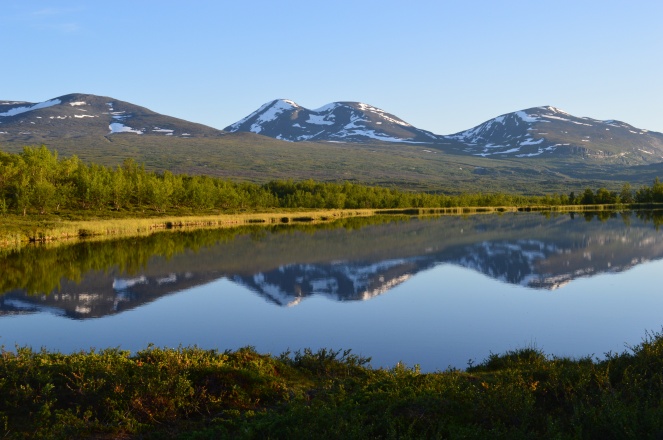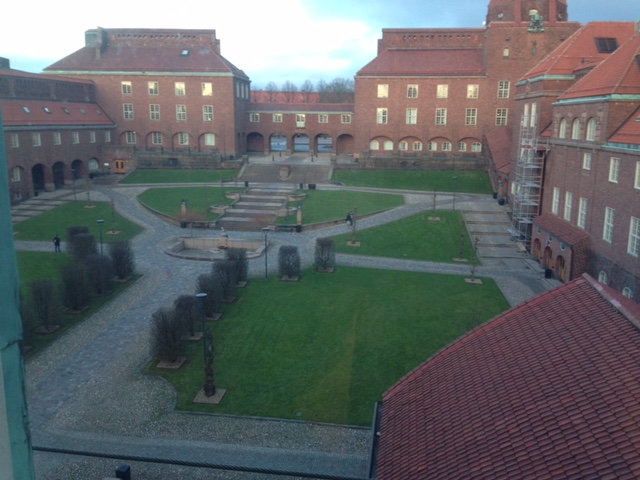
A few weeks ago I wrote a blog post about a “summer talk” in Lövstabruk where professor Ingemar Ernberg from Karolinska Institutet talked about what is needed to support a creative academic environment. Yesterday, I visited Lövstabruk again for yet another inspiring talk. This time, Ulf Danielsson, professor of theoretical physics from Uppsala University was the invited guest. His talk focused on the fatal yet in the short term unlikely threats that are at play out there in the dark, in our atmosphere as well as on and inside the surface of our planet. I will bring up some of the main points here, since I believe that the content of the talk is important to everyone.
It quickly became very clear that our planet is very exposed and that we should consider ourselves very lucky to be around at all. Some of the large forces out there, which we can’t really do anything about are:
- Supernovae – if a star sufficiently close to us (a few 10ths of light years) explodes, our ozone layer could be destroyed and – if it occurs closely enough – our oceans boiled away.
- Hypernovae (this was a new concept to me) – these are even more powerful than supernovae and apparently send out focused rays. If we are hit by such a ray (not too far from the explosion) all will definitely be over for us.
- Asteroids, comets… – there are quite a lot of these moving around and they are often crossing the Earth’s orbit (luckily, we are seldom at the intersection point/time).
- Our sun itself – Ulf referred to the sun as “a giant nuclear plant completely without supervision” :). This pretty much means that there is a constant melt down over there. To top it all off outbursts on the surface of the sun can cause considerable problems for us, especially now when we are so dependent on electronics sensitive to electromagnetic pulses. Also, the radiation from the sun fluctuates and this causes changes between periods with high and low temperatures respectively. We also know that the sun will eventually die, and destroy the life on Earth when it expands in the process, thereby engulfing Mercury, Venus and possibly the Earth.
After a more cosmological beginning, Ulf focused more on the Earth itself. There are obviously large forces in play down here as well. The position of the different continents were brought up as one example. We know that once there was a single continent (Pangea) to begin with. Something obviously broke that land mass apart into differently sized pieces. An especially interesting example was India, which apparently was positioned at the opposite side of the now called Indian Ocean to begin with. That part of land travelled over the ocean, and later got in touch with the other side, so fast that scientists have been able to spot traces on the seafloor from the movement! No similar things are happening now, but we still experience problems with movement between tectonic plates. These activities can, among other things, cause volcanoes to erupt – something that was also brought up as dangerous forces during the talk. Though he did not use the term, he possibly meant supervolcanoes, since ordinary volcanoes erupt now and then without causing large-scale devastation. The lava itself is not the worst part, but rather the ashes that covers the sky preventing sun light, necessary for all photosynthesizing plants, to reach the ground, or acid rain which have been caused by volcanoes in the past. We cannot really do much about any of things as mentioned above, but must remain hoping for the best.
Besides talking about different kinds of threatening scenarios, Ulf also discussed some land marks for the evolution of life on our planet. One part I found especially interesting was the discussion about the birth of the photosynthesis. From the beginning we had methane in our atmosphere, causing the sky to be pink. We didn’t have advanced life on the planet at that point. But when blue-green algae started to show up the photosynthesis and oxygen (which at this point could be considered a dangerous gas) came as a consequence. Most of the oxygen reacted with iron dissolved in the oceans, which in turn caused iron oxide to sink to the seafloor and the heavy mass even continued to move through the bottom towards the core, thus slightly reducing Earth´s inertial momentum and so causing an increase in the Earth’s rotational speed! When there was not more iron to react with, the oxygen molecules began rising to the atmosphere and the sky turned from pink to blue. The rest is, well, history.
In the next part, Ulf talked more about changing temperatures on Earth some of which are due to human activity. One of the most interesting parts here was that India’s “race” over the ocean actually freed up carbon dioxide, causing the climate to be warmer for a period. But that situation changed when the piece of land collided on the other side and started forming the Himalayas – the movement that freed up the carbon dioxide stopped and instead we entered the cool period being sustained until now (although we are currently giving bound carbon dioxide back to the atmosphere at a very worrying rate). Another thing that was brought up regarding reasons for warm and cold periods was that other planets actually affect the Earth’s orbit.
A comparison with temperatures on Mars and Venus also made clear that we are positioned at a very special place in our solar system. The atmosphere on Venus, our closest inner neighbor, is vastly dominated by carbon dioxide causing a huge greenhouse effect – it is extremely hot and impossible for life to survive. The opposite is true on Mars, our closest outer neighbor, where weak gravity makes the atmosphere so thin that the greenhouse effect necessary for life cannot work. We are on a little planet in the middle, having the exact right conditions at least for now. Ulf also showed a picture taken from a space satellite, with stable position on the Sun-Earth connection line, with the Sun right behind, where the “full Moon” was seen covering a part of the “full Earth”. It became clear that we are very close to something grey and largely inhabitable. These comparisons really highlight that we live in a fragile system and Ulf really made the point that we need to think hard about where we are, what we can do with our knowledge about this system and what kind of future we want.
During the discussions after the traditional soup break the human’s role in the changing planet was brought up again. It is obvious that human activity is causing temperatures to rise and the rate is increasing as never before. Ulf thought the worst part of this was the uncertainty – it is very hard to predict the consequences of this. Even if the warming doesn´t cause e.g. drastic changes like mass extinction even minor changes in temperature can obviously cause coastal areas (those now prevailing) to be inhabitable, in turn causing huge floods of climate refugees, paving the way for conflicts and war. The very societies, on which our developed countries are so dependent, are also at risk here and where will those effects leave us? The discussion about the effects of extinction of other species was also brought up. Human activity plays a large role here and even though the extinction of a single species may not cause a catastrophe it is still a means of rendering our very fragile system even more fragile…
As I understand Ulf’s talk was based on his book “Vårt klot så ömkligt litet” (for the moment only in Swedish) which was published last year. I have not read the book, but Birgitta Östlund who organizes the summer talks had. She said that everyone should read the book and she even suggested that it should be mandatory in school. Birgitta has worked with popular adult education for several decades, so when she says something like that one had better take notice. The talk really got me thinking about where I am and what I am a part of and I am very curious about that book now!
The picture for this blog post was taken by me in the mountain range of northernmost Sweden (Abisko) a few years ago and I feel it somehow summarizes what we have been blessed with on this planet. Even though quite a lot seems to be left to chance, we should do what we can to protect the system that can offer us experiences and views like this, right?










